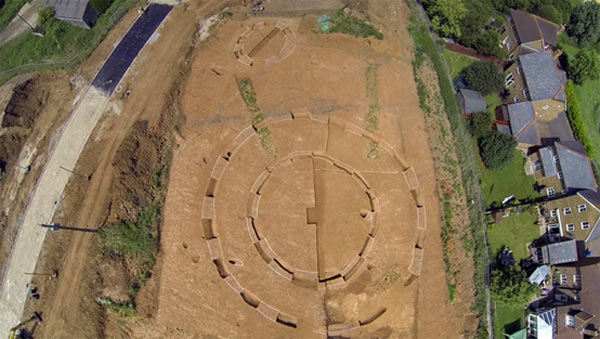6,000-year-old Neolithic henge and barrow uncovered in Kent
Archaeologists in Britain have unearthed an ancient Neolithic henge on housing development grounds in Kent, England. According to a report in Culture24, the massive structure may have been used later on as a funerary complex, known as a barrow, in the Bronze Age, when an inner ring was also added. Researchers have said the ancient monument would have once looked quite similar to Stonehenge.
The discovery was made by Dr Paul Wilkinson and his team from Swale and Thames Archaeological Survey Company (SWAT), who investigated the site ahead of a housing development at Iwade Meadows, Sittingbourne in Kent. They commissioned a local aerial photography drone service called Skyspider Aerial Imaging to capture the spectacular sight. A high definition video of the ancient henge can be seen below.
SWAT Archaeology Iwade project from Skyspider A.I on Vimeo.
The henge measures 30 metres in diameter and is located in a position that would have once had extensive views to the Swale Estuary and the Island of Sheppey beyond. The structure consists of an inner and outer ring. The outer ring has an entrance facing north-east, which suggests it may have originated as a monument, similar to Stonehenge.
The inner ring, as well as a track from the north east leading to the causeway entrance of the ring, were later added in the Bronze Age. Dr Wilkinson believes the track functioned as a ‘sacred way’, along which people formed a procession towards what was most likely a ceremonial gathering place. However, it is believed that the use of the henge changed over the millennia.
“The archaeological evidence suggests that the outer ditch may have originated in the Neolithic and been later transformed in the Bronze Age into a funerary monument with the addition of the inner ring.”

Archaeologists excavating the inner ring of the newly-discovered Henge in Kent. Credit: Skyspider Aerial Imaging
A second smaller monument lies close to the larger rings, and experts believe it may have been a secondary Bronze Age burial mound, known as a barrow, although no human remains have been found yet.
Archaeologists have also found a series of pits close to the monuments, which suggest the site and area were in use before the construction of the henge.
The SWAT archaeology team now hopes to determine the exact date, phasing and character of the monuments.
Featured image: The Neolithic Henge discovered in Kent. Credit: Skyspider Aerial Imaging




















Comments
loved the video within the article!!! great info!
love, light and blessings
AB
too cool